首先,将项目结构调整为android
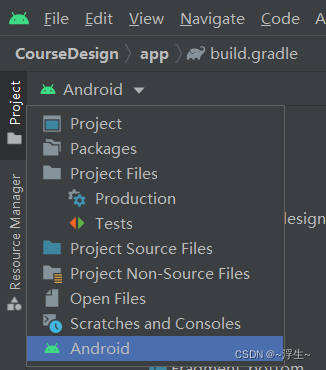
找到AndroidManifest.xml
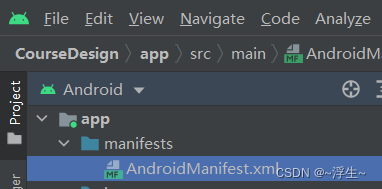
在其中添加访问网络的权限
<uses-permission android:name="android.permission.INTERNET"/>

然后,找到build.gradle文件,后面有.app的那个
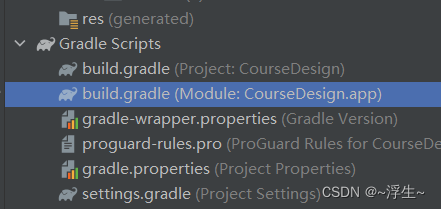
在其中引入okhttp
implementation 'com.squareup.okhttp3:okhttp:3.8.1'
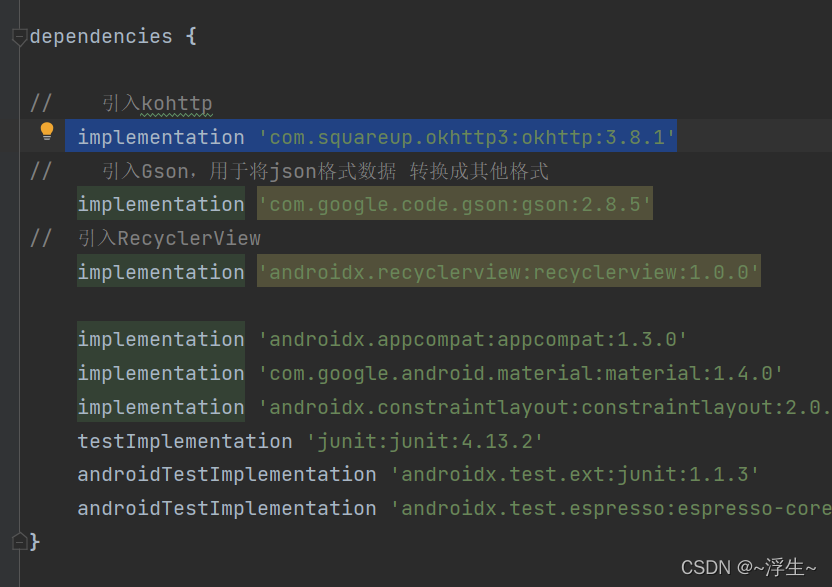
第一种,Get 请求:
String url="http://192.168.125.173:8080/android/loginDispose";
OkHttpClient client=new OkHttpClient();
final Request request=new Request.Builder()
.url(url)
.get()
.build();
Call call=client.newCall(request);
call.enqueue(new Callback() {
@Override
public void onFailure(Call call, IOException e){
Log.d(TAG,"请求失败:"+e);
}
@Override
public void onResponse(Call call, Response response){
// 请求成功后的回调方法,后台返回的数据从response中获得
}
});
第二种,Post请求:
String url="http://192.168.125.173:8080/android/selectShopping";
OkHttpClient okHttpClient = new OkHttpClient();
FormBody formBody = new FormBody.Builder()
.add("loginUserPhone",loginUserPhone).build();
Request request = new Request.Builder()
.url(url)
.post(formBody)
.build();
Call call=okHttpClient.newCall(request);
call.enqueue(new Callback() {
@Override
public void onFailure(Call call, IOException e) {
Log.d(TAG,"请求失败:"+e);
}
@Override
public void onResponse(Call call, Response response) throws IOException {
String str =response.body().string();
}
});
我们用Post请求来举例:
上述Post代码向后台发送了一个String数据
后台使用springboot框架,定义一个相同的参数来接收来自android发送的数据,代码如下

后台打印结果如下:

android请求成功后,后台返回请求的数据,android通过onResponse方法处理回调的数据,打印结果如下:
Log.i("请求返回的数据:",response.body().string());

这样android发送post请求,后台返回数据就都成功了,但也存在一个问题。
如果我发送的post请求携带多个数据,那么后台方法的参数就会非常多,通常我们会将这些数据放到map中
android的代码如下:
String url="http://192.168.125.173:8080/android/loginDispose";
// 存储登录用户的数据
Map<String,String> map=new HashMap<>();
map.put("phone", String.valueOf(phone.getText()));
map.put("password", String.valueOf(password.getText()));
// 将map转换为json对象
JSONObject json=new JSONObject(map);
OkHttpClient okHttpClient = new OkHttpClient();
FormBody formBody = new FormBody.Builder().add("map", String.valueOf(json)).build();
Request request = new Request.Builder()
.url(url)
.post(formBody)
.build();
Call call=okHttpClient.newCall(request);
call.enqueue(new Callback() {
@Override
public void onFailure(Call call, IOException e) {
Toast.makeText(context, "服务器错误!", Toast.LENGTH_LONG).show();
}
@Override
public void onResponse(Call call, Response response) throws IOException {
String str=response.body().string();
}
});
return mark;
后台接收到android发送的map,后台代码如下:
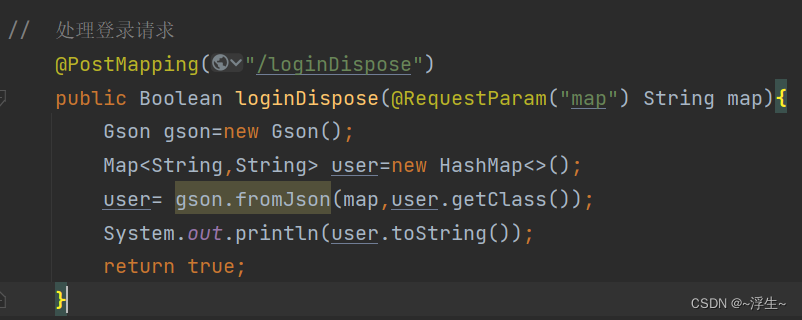
android要发送的用户名和密码,首先被放入map中,然后将map转为JSONObject,最后将json对象转变为String发送到后台
后台通过@RequestParam注解来获得传递的String,new一个Gson对象,通过Gson将String转变为Map
后台打印结果如下:

到此,发送携带多个数据的post请求就完成了,但是还存在一个问题。
如果android向后台发送了一个Post请求,后台返回了一个对象数组,android该怎样处理?
首先,后台的数据库中存在一张product表,并建立了一个与之对应的实体Product类
Product类的代码如下:
public class Product implements Serializable
{
private String uuid;
private String phone;
private String name;
private BigDecimal price;
private String description;
private String picturespath;
private String category;
private Date time;
private String status;
// 一个商品对应多个购物车
private List<Shopping> shoppingList;
public Product(String uuid, String phone, String name, BigDecimal price, String description, String picturespath, String category, Date time, String status) {
this.uuid = uuid;
this.phone = phone;
this.name = name;
this.price = price;
this.description = description;
this.picturespath = picturespath;
this.category = category;
this.time = time;
this.status = status;
}
public Product() {
super();
}
public String getUuid() {
return uuid;
}
public void setUuid(String uuid) {
this.uuid = uuid;
}
public String getPhone() {
return phone;
}
public void setPhone(String phone) {
this.phone = phone;
}
public String getName() {
return name;
}
public void setName(String name) {
this.name = name;
}
public BigDecimal getPrice() {
return price;
}
public void setPrice(BigDecimal price) {
this.price = price;
}
public String getDescription() {
return description;
}
public void setDescription(String description) {
this.description = description;
}
public String getPicturespath() {
return picturespath;
}
public void setPicturespath(String picturespath) {
this.picturespath = picturespath;
}
public String getCategory() {
return category;
}
public void setCategory(String category) {
this.category = category;
}
public Date getTime() {
return time;
}
public void setTime(Date time) {
this.time = time;
}
public String getStatus() {
return status;
}
public void setStatus(String status) {
this.status = status;
}
public List<Shopping> getShoppingList() {
return shoppingList;
}
public void setShoppingList(List<Shopping> shoppingList) {
this.shoppingList = shoppingList;
}
@Override
public String toString() {
StringBuilder sb = new StringBuilder();
sb.append(getClass().getSimpleName());
sb.append(" [");
sb.append("Hash = ").append(hashCode());
sb.append(", uuid=").append(uuid);
sb.append(", phone=").append(phone);
sb.append(", name=").append(name);
sb.append(", price=").append(price);
sb.append(", description=").append(description);
sb.append(", picturespath=").append(picturespath);
sb.append(", category=").append(category);
sb.append(", time=").append(time);
sb.append(", status=").append(status);
sb.append(", shoppingList=").append(shoppingList);
sb.append("]");
return sb.toString();
}
}
android将请求后台product表的所有数据,后台使用MyBatis作为持久层框架,代码如下:

打印结果如下:
android的代码和打印结果如下:


从两次打印结果看,从数据库中获得的数据被转换为JSON格式发送到了android,这是因为@ResponseBody注解的原因
android拿到了JSON格式的数据后做如下处理:
(1)将String转换为JSONArray,JSONArray中的每一个成员都是一个Product对象,所以要在android也建立一个Product类
(2)将JSONArray的每个成员都转换为JSONObject
(3)将JSONObject转换为Product实体类
具体代码如下:
String str =response.body().string();
Gson gson=new Gson();
Product product=new Product();
try {
// 将字符串转换为json数组
JSONArray jsonArray=new JSONArray(str);
for(int i=0;i<jsonArray.length();i++){
// 将Json数组中的元素,拿出来转换成Json对象
JSONObject jsonObject=(JSONObject) jsonArray.get(i);
// 将Json对象转换成实体对象,并加入数组
product=gson.fromJson(String.valueOf(jsonObject),Product.class);
productList.add(product);
}
} catch (JSONException e) {
e.printStackTrace();
}
这里用到了Gson,所以要先引入依赖
打开build.gradle文件,代码如下:
implementation 'com.google.code.gson:gson:2.8.5'
